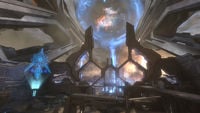Slipspace portal: Difference between revisions
From Halopedia, the Halo wiki
No edit summary |
SpartanLeet (talk | contribs) No edit summary |
||
| (35 intermediate revisions by 13 users not shown) | |||
| Line 1: | Line 1: | ||
{{ | {{Status|Canon}} | ||
[[File:SlipspacePortal intro.jpg | [[File:SlipspacePortal intro.jpg|thumb|300px|A slipspace portal generator on [[Menachite portal complex|Reach]].]] | ||
'''Slipspace portals''' are a method of [[slipstream space]] transit developed by the [[Forerunner]]s. Essentially a large-scale application of [[slipspace translocation]], slipspace portals are designed to transport enormous amounts of mass between two fixed points on a continuing basis.<ref>'''Halo: Cryptum''', ''page 200''</ref><ref>'''Halo: Cryptum''', ''page 274''</ref> | '''Slipspace portals''' are a method of [[slipstream space]] transit developed by the [[Forerunner]]s. Essentially a large-scale application of [[slipspace translocation]], slipspace portals are designed to transport enormous amounts of mass between two fixed points on a continuing basis.<ref>'''Halo: Cryptum''', ''page 200''</ref><ref>'''Halo: Cryptum''', ''page 274''</ref> | ||
| Line 8: | Line 8: | ||
[[File:Array.png|thumb|300px|The Halo Array being deployed into a portal.]] | [[File:Array.png|thumb|300px|The Halo Array being deployed into a portal.]] | ||
===Mechanics=== | ===Mechanics=== | ||
Large constructs, such as the [[Halo Array|Halo installations]], could be transported across interstellar distances through the use of portals. The transition of such a large object would slow down other slipspace traffic in the entire [[Milky Way|galaxy]] due to the buildup of an effect known as [[reconciliation]].<ref>'''Halo: Cryptum''', ''page 104''</ref> While designed for large-scale transit, portals have a limited transit capacity and can be strained or even destroyed if this capacity is exceeded.<ref>'''Halo: Cryptum''', ''pages 313-314''</ref> Portals also have a system that filters unnecessary objects such as debris, discarding them into the volume of slipspace.<ref>'''Halo: Cryptum''', ''page 323''</ref> While passage through a portal is remarkably faster than an ordinary slipspace jump, portal transit is not instantaneous; for example, the passage from the Earth portal to [[Installation 00|the Ark]] took over three weeks.<ref>[http://halo.xbox.com/en-us/intel/featured/video/herofortitude/bfe5038b-314a-4f17-a6be-f7613e0e3788 '''Halo Waypoint''', ''Hero-Fortitude'']</ref> | Large constructs, such as the [[Halo Array|Halo installations]], could be transported across interstellar distances through the use of portals. The transition of such a large object would slow down other slipspace traffic in the entire [[Milky Way|galaxy]] due to the buildup of an effect known as [[reconciliation]].<ref>'''Halo: Cryptum''', ''page 104''</ref> While designed for large-scale transit, portals have a limited transit capacity and can be strained or even destroyed if this capacity is exceeded.<ref>'''Halo: Cryptum''', ''pages 313-314''</ref> Portals also have a system that filters unnecessary objects such as debris, discarding them into the volume of slipspace.<ref>'''Halo: Cryptum''', ''page 323''</ref> While passage through a portal is remarkably faster than an ordinary slipspace jump, portal transit is not instantaneous; for example, the passage from the Earth portal to [[Installation 00|the Ark]] took over three weeks.<ref>[http://halo.xbox.com/en-us/intel/featured/video/herofortitude/bfe5038b-314a-4f17-a6be-f7613e0e3788 '''Halo Waypoint''', ''Hero-Fortitude'']</ref> The portal constructs have unmediated slipspace cores bound to them that generate stable, pre-computed slipspace routes between synchronised endpoints. Due to the fact that these devices have fixed endpoints, destination flexibility is sacrificed for safety, speed, and security.<ref name="WF11">''Halo: Warfleet'', p.11</ref> | ||
Portals may be generated by groundside facilities which vary in overall architecture but are typically enormous, | Portals may be generated by groundside facilities which vary in overall architecture but are typically enormous,{{Ref/Reuse|noon}} or generator systems situated in space.{{Ref/Reuse|c312}}<ref name="MB portal">'''Halo: Silentium''', ''page 308''</ref> Portals generated within an atmosphere are often accompanied by [[Portal storm|severe weather disturbances]].{{Ref/Reuse|noon}}{{Ref/Reuse|h3}} Dedicated [[ancilla]]s were often tasked with maintaining portals. Certain portals are designed to activate only when a specific code sequence is transmitted or a device, such as the [[Conduit]], is inserted into [[unidentified Forerunner machine|a machine]] capable of generating such portals.{{Ref/Reuse|MB portal}}<ref name="opc">'''[[Halo: Spartan Strike]]''', ''[[Operation C: Valiant Hammer]]''</ref><ref name="opd">'''[[Halo: Spartan Strike]]''', ''[[Operation D: Adamantine Shield]]''</ref> Others, such as the [[Portal at Voi|one on Earth]], require a [[keyship]] to function.{{Ref/Reuse|h3}} Halo Installations are capable of generating slipspace portals if necessary to reach a destination.<ref name="P343">'''Halo: Primordium''', ''pages 343-346''</ref><ref name="HW2">'''[[Halo Wars 2]]'''</ref> | ||
===Appearance=== | ===Appearance=== | ||
| Line 16: | Line 16: | ||
==Usage== | ==Usage== | ||
The Forerunners had a network of portals that allowed fast passage throughout their [[ecumene]]. Some systems, including that of the [[capital]], had portal installations that connected to multiple worlds. | The Forerunners had a network of portals that allowed fast passage throughout their [[ecumene]]. Some systems, including that of the [[capital]], had portal installations that connected to multiple worlds.{{Ref/Reuse|c312}} The [[Librarian]] used an array of portals to travel to the worlds where she collected the various species of the galaxy for indexing at [[Installation 00|the Ark]]. The same network was used to transport the Halo rings.<ref>'''Halo: Cryptum''', ''page 310''</ref> The portals in this network could only be activated by a special type of vessel, known as a [[keyship]],<ref>[https://halo.xbox.com/en-us/news/headline/the-halo-bulletin-11911-/290676 '''Halo Waypoint''': ''The Halo Bulletin: 11/9/11'']</ref> most of which were eventually destroyed by the Librarian in order to prevent the [[Flood]] from reaching the Ark.<ref>'''Halo 3''', ''[[Terminal (Halo 3)#Terminal Four|Terminal 4]]''</ref> The [[The Portal|generator device]] for one of the Librarian's portals was buried near the town of [[Voi]] on [[Earth]], and was later activated by the Covenant, who were in possession of the ''[[Anodyne Spirit]]'', the last known remaining keyship that would simply be known as the [[Anodyne Spirit|Forerunner Dreadnought]].{{Ref/Reuse|h3}} [[Faber]], the [[Master Builder]], had a secret private portal constructed allowing transit from the vicinity of the [[greater Ark]] to [[Installation 00]]. This portal could only be activated by inserting a specific code known only to the Master Builder. Transit through the portal was also distinctly more comfortable than in most normal slipspace portals due to the Master Builder's wealth and power.{{Ref/Reuse|MB portal}} On [[Reach]] was [[Menachite portal complex|a portal complex]] that could be used to connect to the Ark. Unlike the portal on Earth, this one only remained open for as long as the local charge lasted and could close in minutes to hours.<ref>'''[[Halo: Shadows of Reach]]'''</ref> | ||
An unknown variant of a portal-generating [[unidentified Forerunner machine|machine]] was present in the jungles of [[Installation 03]], and was only able to be activated via the Conduit's interaction with another machine found at the installation's [[Altar]] complex. Furthermore, the activation of the Altar triggered the opening of slipspace portals around the galaxy by way of these generator machines; one such machine in the Halo's jungle directly linked to another machine residing in [[New Phoenix ONI facility|an ONI facility]] in [[Arizona]] on Earth, enabling slipspace travel between the two locations. It is unknown if these portals provide two-way travel between Installation 03 and Earth exclusively, or are part of the Forerunner's vast network of portals at large.<ref name="opc"></ref><ref name="opd"></ref><ref name="ope">'''[[Halo: Spartan Strike]]''', ''[[Operation E: Brother's Keeper]]''</ref> | An unknown variant of a portal-generating [[unidentified Forerunner machine|machine]] was present in the jungles of [[Installation 03]], and was only able to be activated via the Conduit's interaction with another machine found at the installation's [[Altar]] complex. Furthermore, the activation of the Altar triggered the opening of slipspace portals around the galaxy by way of these generator machines; one such machine in the Halo's jungle directly linked to another machine residing in [[New Phoenix ONI facility|an ONI facility]] in [[Arizona]] on Earth, enabling slipspace travel between the two locations. It is unknown if these portals provide two-way travel between Installation 03 and Earth exclusively, or are part of the Forerunner's vast network of portals at large.<ref name="opc"></ref><ref name="opd"></ref><ref name="ope">'''[[Halo: Spartan Strike]]''', ''[[Operation E: Brother's Keeper]]''</ref> | ||
Though the Librarian's portal network was utilized to transport the Halo rings, the rings themselves are capable of generating portals for transport if necessary. After [[Installation 07]]'s near-collision with the [[wolf-faced planet]], the [[IsoDidact]] had the installation, boosted by power from [[Forerunner dreadnought]]s, generate a limited portal to travel to the [[greater Ark]] for repairs, but the limited power and severe damage meant that the installation had to shed 20,000 kilometers of its mass to make it through.{{Ref/Reuse|P343}} Similarly, [[Installation 09]] was able to open a portal for its transit to the [[Soell system]] when it was launched in [[2559]].{{Ref/Reuse|HW2}} | |||
Several of the structures on [[Sarcophagus]] contained slipspace portals not just to other parts of the [[shield world]], but to other planets entirely<ref>'''[[Halo: The Thursday War]]''', ''page 409''</ref> including [[Hesduros]] in an entirely different star system<ref name="TW398">'''[[Halo: The Thursday War]]''', ''page 398''</ref> and [[Mackintosh]] which was not only within the [[Zeta Doradus system]], but fell into orbit of Sarcophagus when the shield world was removed from its [[slipspace bubble]].<ref name="L404">'''[[Halo: Legacy of Onyx]]''', ''page 404''</ref> These two portals were used by [[Jul 'Mdama]] to escape and the [[Servants of the Abiding Truth]] to travel to Mackintosh respectively.{{Ref/Reuse|TW398}}{{Ref/Reuse|L404}} | |||
In [[2558#August|August 2558]], [[Rion Forge]] was pulled through a slipspace portal{{Ref/Novel|PoL|16}} opened by the [[Precept]]{{Ref/Novel|PoL|35}} using a [[personal slipspace unit]]{{Ref/Novel|PoL|19}} that transported her from Installation 07 to a Forerunner facility on [[Erebus VII]]. | |||
On [[2559#December|December 13, 2559]], Cortana transported Installation 07 through a slipspace portal to an unknown location just before sacrificing herself to destroy part of the ring.{{Ref/Novel|RP|Chapter=4}} Lieutenant [[TJ Murphy]] theorized that the ring could've been sent clear across the galaxy or even to [[Intergalactic space]].{{Ref/Novel|RP|13}} | |||
==Trivia== | ==Trivia== | ||
| Line 27: | Line 35: | ||
<gallery> | <gallery> | ||
File:Ark portal open.jpg|The active portal complex at [[Voi]]. | File:Ark portal open.jpg|The active portal complex at [[Voi]]. | ||
File:H3_VoiPortal_Above.jpg|Top-down view of the Portal at Voi. | |||
File:PortalGeneratorPanorama.jpg|A slipspace portal as seen from its [[High Noon|observation station]]. | File:PortalGeneratorPanorama.jpg|A slipspace portal as seen from its [[High Noon|observation station]]. | ||
File:Highnoon 01.jpg|Another view of the same portal and station. | File:Highnoon 01.jpg|Another view of the same portal and station. | ||
| Line 38: | Line 47: | ||
*''[[Halo: Cryptum]]'' | *''[[Halo: Cryptum]]'' | ||
*''[[Halo: Combat Evolved Anniversary]]'' | *''[[Halo: Combat Evolved Anniversary]]'' | ||
**''[[Terminal | **''[[Terminal (Halo: Combat Evolved Anniversary)|Terminals]]'' | ||
*''[[Halo: Primordium]] | *''[[Halo: Primordium]]'' | ||
*''[[Halo 4]]'' | |||
*''[[Halo: Silentium]]'' | *''[[Halo: Silentium]]'' | ||
*''[[Halo: Escalation]]'' | *''[[Halo: Escalation]]'' | ||
| Line 45: | Line 55: | ||
*''[[Halo Mythos]]'' | *''[[Halo Mythos]]'' | ||
*''[[Halo Wars 2]]'' | *''[[Halo Wars 2]]'' | ||
*''[[Halo: Shadows of Reach]]'' | |||
*''[[Halo: Point of Light]]'' | |||
*''[[Halo: Divine Wind]]'' | |||
*''[[Halo: The Rubicon Protocol]]'' | |||
*''[[Halo: Epitaph]]'' | |||
==Sources== | ==Sources== | ||
{{Ref/Sources}} | |||
{{Forerunner|technology}} | {{Forerunner|technology}} | ||
Latest revision as of 10:52, March 9, 2024

Slipspace portals are a method of slipstream space transit developed by the Forerunners. Essentially a large-scale application of slipspace translocation, slipspace portals are designed to transport enormous amounts of mass between two fixed points on a continuing basis.[1][2]
Although distinct from fixed-point portal transit, the slipspace ruptures opened by a starship's slipspace drive are also sometimes termed as "portals".[3]
Description[edit]
Mechanics[edit]
Large constructs, such as the Halo installations, could be transported across interstellar distances through the use of portals. The transition of such a large object would slow down other slipspace traffic in the entire galaxy due to the buildup of an effect known as reconciliation.[4] While designed for large-scale transit, portals have a limited transit capacity and can be strained or even destroyed if this capacity is exceeded.[5] Portals also have a system that filters unnecessary objects such as debris, discarding them into the volume of slipspace.[6] While passage through a portal is remarkably faster than an ordinary slipspace jump, portal transit is not instantaneous; for example, the passage from the Earth portal to the Ark took over three weeks.[7] The portal constructs have unmediated slipspace cores bound to them that generate stable, pre-computed slipspace routes between synchronised endpoints. Due to the fact that these devices have fixed endpoints, destination flexibility is sacrificed for safety, speed, and security.[8]
Portals may be generated by groundside facilities which vary in overall architecture but are typically enormous,[9] or generator systems situated in space.[10][11] Portals generated within an atmosphere are often accompanied by severe weather disturbances.[9][12] Dedicated ancillas were often tasked with maintaining portals. Certain portals are designed to activate only when a specific code sequence is transmitted or a device, such as the Conduit, is inserted into a machine capable of generating such portals.[11][13][14] Others, such as the one on Earth, require a keyship to function.[12] Halo Installations are capable of generating slipspace portals if necessary to reach a destination.[15][16]
Appearance[edit]
Portals are similar in appearance to a slipspace rupture generated by a slipspace drive, appearing as holes into the pitch-black void of slipspace and surrounded by blue-violet energy and supported by a web of hard light.[12][10] Some portals, however, allow visibility to the destination on the other side.[17][9]
Usage[edit]
The Forerunners had a network of portals that allowed fast passage throughout their ecumene. Some systems, including that of the capital, had portal installations that connected to multiple worlds.[10] The Librarian used an array of portals to travel to the worlds where she collected the various species of the galaxy for indexing at the Ark. The same network was used to transport the Halo rings.[18] The portals in this network could only be activated by a special type of vessel, known as a keyship,[19] most of which were eventually destroyed by the Librarian in order to prevent the Flood from reaching the Ark.[20] The generator device for one of the Librarian's portals was buried near the town of Voi on Earth, and was later activated by the Covenant, who were in possession of the Anodyne Spirit, the last known remaining keyship that would simply be known as the Forerunner Dreadnought.[12] Faber, the Master Builder, had a secret private portal constructed allowing transit from the vicinity of the greater Ark to Installation 00. This portal could only be activated by inserting a specific code known only to the Master Builder. Transit through the portal was also distinctly more comfortable than in most normal slipspace portals due to the Master Builder's wealth and power.[11] On Reach was a portal complex that could be used to connect to the Ark. Unlike the portal on Earth, this one only remained open for as long as the local charge lasted and could close in minutes to hours.[21]
An unknown variant of a portal-generating machine was present in the jungles of Installation 03, and was only able to be activated via the Conduit's interaction with another machine found at the installation's Altar complex. Furthermore, the activation of the Altar triggered the opening of slipspace portals around the galaxy by way of these generator machines; one such machine in the Halo's jungle directly linked to another machine residing in an ONI facility in Arizona on Earth, enabling slipspace travel between the two locations. It is unknown if these portals provide two-way travel between Installation 03 and Earth exclusively, or are part of the Forerunner's vast network of portals at large.[13][14][22]
Though the Librarian's portal network was utilized to transport the Halo rings, the rings themselves are capable of generating portals for transport if necessary. After Installation 07's near-collision with the wolf-faced planet, the IsoDidact had the installation, boosted by power from Forerunner dreadnoughts, generate a limited portal to travel to the greater Ark for repairs, but the limited power and severe damage meant that the installation had to shed 20,000 kilometers of its mass to make it through.[15] Similarly, Installation 09 was able to open a portal for its transit to the Soell system when it was launched in 2559.[16]
Several of the structures on Sarcophagus contained slipspace portals not just to other parts of the shield world, but to other planets entirely[23] including Hesduros in an entirely different star system[24] and Mackintosh which was not only within the Zeta Doradus system, but fell into orbit of Sarcophagus when the shield world was removed from its slipspace bubble.[25] These two portals were used by Jul 'Mdama to escape and the Servants of the Abiding Truth to travel to Mackintosh respectively.[24][25]
In August 2558, Rion Forge was pulled through a slipspace portal[26] opened by the Precept[27] using a personal slipspace unit[28] that transported her from Installation 07 to a Forerunner facility on Erebus VII.
On December 13, 2559, Cortana transported Installation 07 through a slipspace portal to an unknown location just before sacrificing herself to destroy part of the ring.[29] Lieutenant TJ Murphy theorized that the ring could've been sent clear across the galaxy or even to Intergalactic space.[30]
Trivia[edit]
The Halo: Reach multiplayer map High Noon is set in an observation platform of a portal generator. This portal facility is noticeably different from the Earth portal; in addition to a different structural design, the area of space beyond the portal is visible, as opposed to complete blackness. This particular portal device also generates a storm of swirling debris in the immediate area around the portal, just beyond the map's borders.[31]
Gallery[edit]

|
Browse more images in this article's gallery page. |
The active portal complex at Voi.
A slipspace portal as seen from its observation station.
List of appearances[edit]
- Halo 3 (First appearance)
- Halo Legends
- Halo: Reach
- Halo: Cryptum
- Halo: Combat Evolved Anniversary
- Halo: Primordium
- Halo 4
- Halo: Silentium
- Halo: Escalation
- Halo: Spartan Strike
- Halo Mythos
- Halo Wars 2
- Halo: Shadows of Reach
- Halo: Point of Light
- Halo: Divine Wind
- Halo: The Rubicon Protocol
- Halo: Epitaph
Sources[edit]
- ^ Halo: Cryptum, page 200
- ^ Halo: Cryptum, page 274
- ^ Halo: Silentium, page 188
- ^ Halo: Cryptum, page 104
- ^ Halo: Cryptum, pages 313-314
- ^ Halo: Cryptum, page 323
- ^ Halo Waypoint, Hero-Fortitude
- ^ Halo: Warfleet, p.11
- ^ a b c Halo: Combat Evolved Anniversary, multiplayer map High Noon
- ^ a b c Halo: Cryptum, page 312
- ^ a b c Halo: Silentium, page 308
- ^ a b c d Halo 3, campaign levels, The Storm and Floodgate
- ^ a b Halo: Spartan Strike, Operation C: Valiant Hammer
- ^ a b Halo: Spartan Strike, Operation D: Adamantine Shield
- ^ a b Halo: Primordium, pages 343-346
- ^ a b Halo Wars 2
- ^ Halo: Combat Evolved Anniversary, Terminal 2
- ^ Halo: Cryptum, page 310
- ^ Halo Waypoint: The Halo Bulletin: 11/9/11
- ^ Halo 3, Terminal 4
- ^ Halo: Shadows of Reach
- ^ Halo: Spartan Strike, Operation E: Brother's Keeper
- ^ Halo: The Thursday War, page 409
- ^ a b Halo: The Thursday War, page 398
- ^ a b Halo: Legacy of Onyx, page 404
- ^ Halo: Point of Light, chapter 16
- ^ Halo: Point of Light, chapter 35
- ^ Halo: Point of Light, chapter 19
- ^ Halo: The Rubicon Protocol, chapter 4
- ^ Halo: The Rubicon Protocol, chapter 13
- ^ Halo Waypoint: The Halo Bulletin: 10/19/11
| ||||||||




